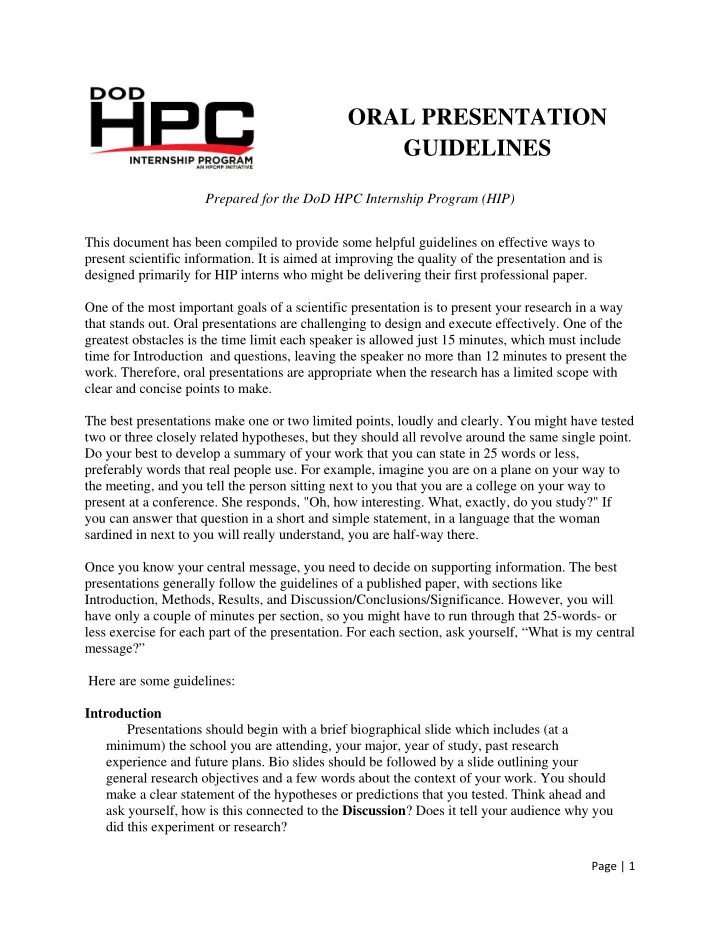

ORAL PRESENTATION GUIDELINES Prepared for the DoD HPC Internship Program (HIP) This document has been compiled to provide some helpful guidelines on effective ways to present scientific information. It is aimed at improving the quality of the presentation and is designed primarily for HIP interns who might be delivering their first professional paper. One of the most important goals of a scientific presentation is to present your research in a way that stands out. Oral presentations are challenging to design and execute effectively. One of the greatest obstacles is the time limit each speaker is allowed just 15 minutes, which must include time for Introduction and questions, leaving the speaker no more than 12 minutes to present the work. Therefore, oral presentations are appropriate when the research has a limited scope with clear and concise points to make. The best presentations make one or two limited points, loudly and clearly. You might have tested two or three closely related hypotheses, but they should all revolve around the same single point. Do your best to develop a summary of your work that you can state in 25 words or less, preferably words that real people use. For example, imagine you are on a plane on your way to the meeting, and you tell the person sitting next to you that you are a college on your way to present at a conference. She responds, "Oh, how interesting. What, exactly, do you study?" If you can answer that question in a short and simple statement, in a language that the woman sardined in next to you will really understand, you are half-way there. Once you know your central message, you need to decide on supporting information. The best presentations generally follow the guidelines of a published paper, with sections like Introduction, Methods, Results, and Discussion/Conclusions/Significance. However, you will have only a couple of minutes per section, so you might have to run through that 25-words- or less exercise for each part of the presentation. For each section, ask yourself, “What is my central message?” Here are some guidelines: Introduction Presentations should begin with a brief biographical slide which includes (at a minimum) the school you are attending, your major, year of study, past research experience and future plans. Bio slides should be followed by a slide outlining your general research objectives and a few words about the context of your work. You should make a clear statement of the hypotheses or predictions that you tested. Think ahead and ask yourself, how is this connected to the Discussion ? Does it tell your audience why you did this experiment or research? Page | 1
Design/Methods You should strive to keep your methods section brief. Don't be so brief that we can't figure out what you did, but do give some thought to what is really relevant to this particular presentation. Data/Results Tell what you found out. Did your tests come out the way you expected? This section will be supported by graphics of your data and statistics. This section may be shorter than you first expect, and this is ok! The more concise and clear your results are, the more time you have to talk about their importance. And it is better to have quick results that are really important than lots of results that aren’t. Discussion and Conclusions This is a section that is often overlooked in oral presentations. Speakers run short of time and rush through this, the most crucial part of the talk. Don't let this happen to you. Consider the major point that you want your audience to remember about your talk. Discuss not only what your results show but also why they are SIGNIFICANT (significant meaning important, not statistically significant). Demonstrate how your research relates to the larger picture or issues. Indicate why anyone should care about your findings. This will summarize your study and send the audience off on a high note. Acknowledgements and References It is becoming increasingly common to acknowledge sources of support and research assistance at some point in the presentation. In addition to a short credit line acknowledging High Performance Computing Modernization Program (HPCMP) and the HPC Internship Program (HIP) sponsorship, we recommend citing just a few sources, focusing on those papers that are seminal in your field or particularly relevant to your research. We strongly recommend that you look to your mentor and colleagues for assistance. When you think you have got the content outlined, even in a rough form, try it out on your mentor, your office mate, and your parents. If they get what you are trying to say, then you're on the right track. The first question that many students ask is how many slides to show. Some experts recommend one slide per minute, but this is probably a little slow. Speakers should certainly allow at least one minute for some slides especially the graphs of data, which need to be talked about at length – but other slides might go much faster. You might plan on about 25 slides for a 12-minute talk. You must bear in mind each presentation is different and so the best approach will depend upon the material you are presenting. There are many ways to make your visual aids. You presentation p should be made in PowerPoint. Preparing a PowerPoint presentation can be very intimidating the first time, but with the knowledge of a few of the programs little tricks it can be the most versatile form of presenting a talk. First, we recommend you find a friend to show you the program if you’ve never used it before. When you open the program select New presentation, choose a blank presentation rather than a premade one, because these are made for the business world and aren’t great for scientific presentations. Then choose the first slide that you want (all text, text and a Page | 2
Recommend
More recommend